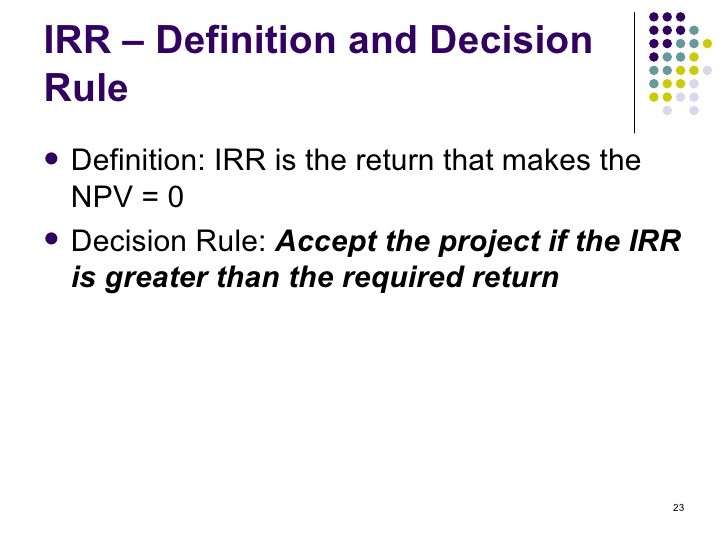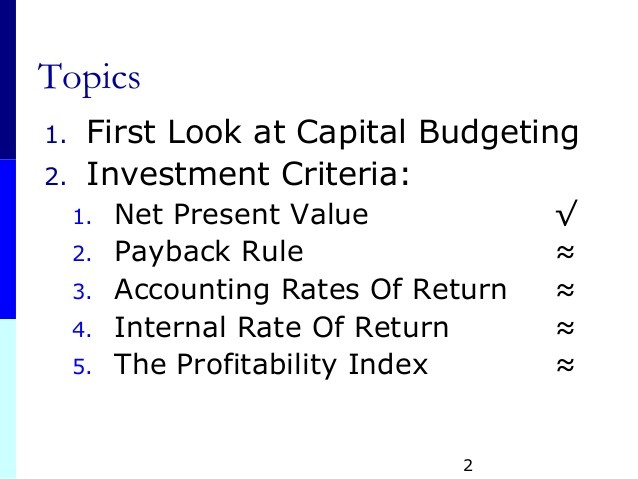Topic 4 Capital Budgeting (Introduction) Net Present Value And Other Investment Criteria Uni
Post on: 10 Апрель, 2015 No Comment

Contents
Required Reading
Essentials of Corporate Finance (2nd Australian and New Zealand edition), by Stephen A. Ross, Rowan Traylor, Ron Bird, Randolph W. Westerfield and Bradford D. Jordan, McGraw Hill Irwin, 2010. pp. 224-259.
Capital Budgeting
Capital budgeting. the investment decision is the process of analysing projects & making a decision as to which ones to invest into. It often involves large cash outlays that generate cash flows later on. We focus on Evaluation & selection of those proposals – proposal description, estimate of the amount, risk & timing of cash flows.
Independent Projects are investments that have no impact on each other’s cash flows. A decision to accept or reject a project does not have an impact on whether another project is accepted or rejected. i.e. could reject them all or accept all.
Mutually exclusive Projects are investments in which accepting 1 project requires the rejection of all others. Possibly due to financial constraints or limitations to available assets (e.g. build an office/warehouse on avail. land). Projects are ranked — we need to work out which is the best.
Methods of Project Evaluation
- NPV — DCF Method — The difference between the present value (PV) of net cash flows (discounted at a specific required rate of return) & the initial outlay
- Advantages. Consistent with maximising shareholder wealth. Measures how much value is created, Time Value of Money (TVOM)

Discounted Cash Flow Methods
DCF methods are superior as they account for the timing of cash flows & the time value of money. In practice DCF methods may be used in conjunction with payback period method. For Independent projects. NPV & IRR lead to the same decision except for when there are multiple or no internal rate of returns (which may occur with non conventional projects). For Mutually exclusive projects, NPV & IRR can provide different ranking orders but the NPV is considered superior (accounts for size). A project with a higher IRR is less sensitive to changes in the discount rate.
If the Discount Rate (DR) < Crossover Rate pick Turtle, if DR > Crossover Rate pick Rabbit.
Assuming Discount Rate = 10%, Pick Turtle as Cross Over Rate > Discount Rate & NPV > 0 (@ RR=10%)
Example
NPV’s cross at 6% (crossover rate), project B has a higher NPV at a lower ‘k’ whilst project A has a higher NPV if k > 6%.
For independent projects. under the IRR method, both will be chosen if the IRR’s (16% & 21%) are greater than the firms hurdle or discount rate. Under the NPV method at 10% both are chosen as NPV > 0 (275 & 223) — it gives the same answer.
For mutually exclusive projects. the IRR method would select project A. If the discount rate is greater than the crossover rate than the NPV method will choose project A, but if the discount rate is less than the crossover rate project B is chosen.
The IRR & NPV methods in this case may disagree ; other factors will need to be considered e.g. distribution of each projects cash flow.
Multiple IRR’s
[3] It is possible for a project to have more than 1 IRR; it occurs when there is more than 1 cash out flow (non-normal cash flows). It makes IRR methodology hard to use.














